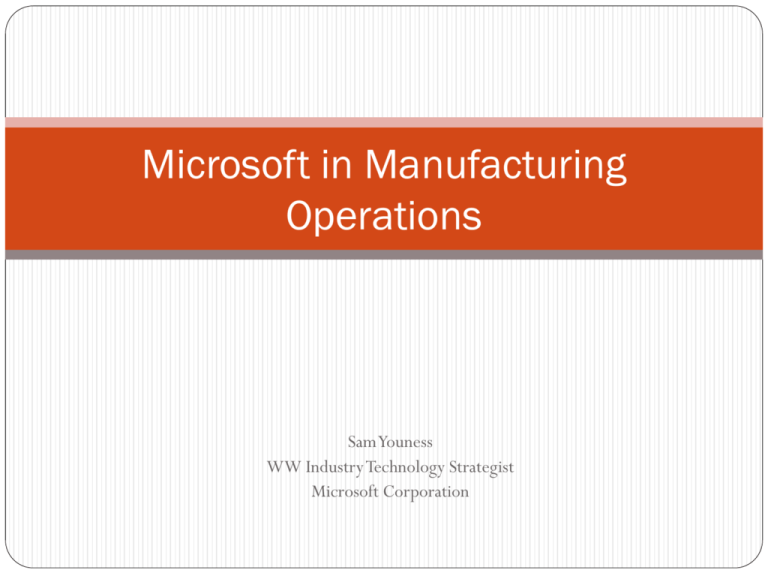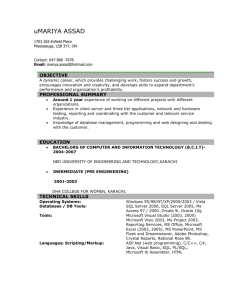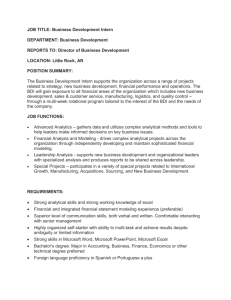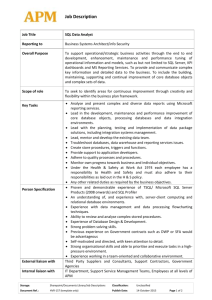
Microsoft in Manufacturing
Operations
Sam Youness
WW Industry Technology Strategist
Microsoft Corporation
What are we going to cover?
Microsoft and its partners in manufacturing operations
Microsoft focus areas in manufacturing operations
Manufacturing visibility pillars
Collaboration
Integration
Business intelligence
Security
Virtualization
Q&A
Manufacturing Environment SP95 Levels
Relative Network
Response
Requirement
Overview
Network Levels
Min. to Hour
Response
Enterprise Network
4
Control System Network Zone
3
<5 Minute Data
Update Time
MES Network
0, 1, 2
Critical Controls Network Zone
1 -2 Second Data
Update
HMI Network
Interlock Network
I/O Network
<1 Second Data
Update
I/O Network
<.1 Second Data
Update
Enterprise Asset Management
(EAM/SAM)
Control Systems, DCS, &
Automated Equipment
Production Control/MES
SCADA and HMI
Shipping/Receiving Materials
Handling
Laboratory Information
Management
Quality Management
Document Management
Regulatory Affairs EH&S
Typical Plant Operation Applications
Manufacturing Solutions
Customer Requirements
System Integrators
Independent Software Vendors
Microsoft Solutions Offerings
Six Sigma and RosettaNet Accelerators
Microsoft Products and Technology
.NET,Visual Studio,Windows, Office, SQL Server…..
Manufacturing Partner Ecosystem
Microsoft and our ISV’s – One Solution
Vendor Solution
Scorecards
Dashboards
Analytics
Planning
• OLAP analysis
• Provide visibility into
business operations and
factors impacting the
business
• Allowing for more
flexibility and timely
decision making
• Build reliable plans fast
• Aligning plans to business
operations and driving
accountability
Reporting
Collaboration
• Create and monitor KPIs
• Visually present KPIs in a
browser, SharePoint, or
Office documents
• Allow for annotation of
KPIs for better
collaboration
• Management reports
based on the analytics
• Roll-up of data to
different levels in easy to
create and understand
reports
• Integration with SQL
Server BI: Reporting
Services
Overviews
Scorecards,
dashboards, and
KPIs:
•Ability to view
real-time, historical,
and business data
side by side.
• Powerful visual
dashboards delivered to
each employee desktop
• Dashboards combine
KPIs, reports, analytics,
among other things
• Integration with
SharePoint
• Special webparts
• Notifications and alerts
Budgeting
• Create models for the
business allowing for
building budgets and
submitting such budgets
using workflow
Workflow
• Integration with
SharePoint
• Allows organizations for
deeper contribution to
plans, budgets, and
forecasts
Forecasting
• Provide insight into any
trends that would help
with decision making
Administration
• Centrally managed
budgets, plans, forecasts
• Allowing models with
business rules
• Integration with Excel
for modeling and
consistent forms
• Role-based security
Blending
Operations:
•Date validation,
•Quality Assurance
Manufacturing
Visibility
• Enhanced visibility
into manufacturing
operations.
• Continuous process
improvement
• Enhanced planning
• Asset efficiency
increase
Process Operations,
Equipment
Monitoring:
•Monitor
equipment usage
and labor cost
•Forecast
maintenance events
Quality:
•Enhancement,
• Monitoring,
• Triggers and
• Events
Inventory:
•Tracking,
Forecasting,
•Integration with
Supply-Chain and
clear view of
material usage
Support for
Industry Specific
KPIs:
•Support for S-95
structures
•Rapid deployment
and flexibility
Consolidation
• Allowing users to analyze
their data, monitor
progress, and plan their
business in the same
application
• Integration with SQL
Server BI and with Office
tools: Outlook, Excel,
SharePoint
Analytical
Foundation:
• Powerful data
model feeding into
the dashboards and
portals
• Secure
• scalable
• Reliable
• Workflow support
• Low TCO
Collaboration
Foundation:
• Workflow support
• Integration
between
intelligence and
execution.
Enterprise Applications Integrated With Plant Operations
Customer Relationship
Management (CRM)
Control Systems, DCS and
Automated Equipment
Enterprise Asset
Management (EAM/SAM)
Shipping/Receiving
Materials Handling
Supply Chain Management
(SCM)
Business
Intelligence and
Enterprise
Performance
Management
Enterprise Resource
Planning (ERP)
Production Control/MES
Plant Operations
Floor
Plant
Visibility
Enterprise
Manufacturing
Visibility
SCADA and HMI
Quality Management
Laboratory Information
Management
Product Lifecycle
Management (PLM)
Document Management
Regulatory Affairs EH&S
Missing Link: Plant Operations Impact on Results Inventory, Processes, Orders, Resources, Status,
Downtime, Products, Lab Results, Exceptions
Plant Operations Focus Areas Mapped to ISA-95 Functional
Hierarchy
Plant Floor Visibility
Business Planning
Level 4
Level 3
Quality
and Logistics
Manufacturing
Manufacturing
Operations and Control
Execution
ERP
MES
Maintenance
Continuous
Discrete
Levels Batch
Control
Control
Control
Control
2,1,0 Manufacturing Control Systems
Microsoft Plant Floor Visibility Pillars
Security
Infrastructure
Plant Operations
Integration
Collaboration
Enterprise
Manufacturing
Visibility
Analytics
Integration
Enterprise
Business Processes
Aggregating data from various
sources and interoperating
between groups
Analytics
Converting aggregated
data into information
Collaboration
Sharing the right information with
the right people at the right time
Plant Floor To Enterprise Integration
Enterprise Systems
Manufacturing Execution
HIS MSMQ
Systems
SCM
HR
FIN
SSB in SQL
Server 2005
BizTalk
Plans,
Schedules
HMI / SCADA / Cell Controllers
Inventory, Labor,
Maintenance, Quality
SSIS in SQL
Products,
BOMs,
Routings,
Recipes,
Server
2005
Procedures
Alarms
and
Events
History
Production and Process Data
Windows
Communication
Foundation
Automation and Control Systems
DCS/PLC/LIMS
Tags
Variables
Data Points
PerformancePoint/SharePoint/Other
CRM
Integration Standards Progress In Manufacturing
Standards boost interoperability over time
Multiple vendors build to standards
1994-Future
OAGIS
XML Bus. Obj
Docs/Msgs
1996-Future
SCOR Make
Model and
Metrics
2002 – Future
WBF B2MML
XML Schemas
Manufacturing Integration Standards Timeline
1995-2001
OPC
Device
Connectivity
1997-Future
ISA 95
Enterprise
Control SI
1988-2003
ISA SP88
Batch
Control
2005-Future
ISA, WBF
OAGIS
Unify models
Ten Years of Microsoft BI … and beyond
PM
Corporate
Decisions
BI
Personal and
Team Insights
DW
BSM
Excel ‘9’
Sound
Data
OLAP
1998
SSRS
PPS V1
PPS V2
Excel ‘14’
MOSS BI
Self-Service
Embedded BI
Excel ‘12’
Enterprise OLAP
EDW
MDM
2008
Wave 14
What Analysts are Saying…
Driving Analytics To Increase Manufacturing
Intelligence
CRM
FIN
HMI / SCADA / Cell Controllers
Automation and Control Systems
DCS / PLC / LIMS
SQL Server 2005\8
Reporting Services
Plans,
Schedules
SQL Server 2005\8
Analysis Services
Manufacturing Execution
Systems
HR
PerformancePoint
BSM 2005
SQL Server 2005\8
Integration Services
Operational Tactical Strategic
Enterprise Systems
SCM
Inventory, Labor,
Maintenance, Quality
Products,
BOMs, Routings, Recipes,
Procedures
Alarms
and
Events
History
Production and Process Data
Tags
Variables
Data Points
Excel & Excel Add-in
SQL/AS
Collaboration In Manufacturing
CRM
Enterprise Systems
SCM
HR
FIN
Enterprise Content
Management
Manufacturing Execution
Systems
SharePoint
Portal
Inventory, Labor,
Plans,
Schedules
Automation
and Workflow
HMI / SCADA / Cell Controllers
Maintenance, Quality
Products,
BOMs, Routings, Recipes,
Procedures
Alarms
and
Events
History
InfoPath
Production and Process Data
Automation and Control Systems
DCS / PLC / LIMS
Tags
Variables
Data Points
The Architecture
Collect
Store and
Integrate
Validate
Visualize and
Analyze
Smart client or
portals
Data
Collection
from various
sources
·
·
·
·
Site 1
Analysis Server
Reporting Server
Adhoc Reporting
Drill-down
PLC/DCS
Site 2
Site 3
Site 4
Rich User
Experience
Launch
from
portal
Workstation
Hand
helds
Share and Collaborate
Enterprise Application Interface (EAI)
Orchestration, Workflow, Integration,
Transformation, Rules Engine, BPEL
Web Services
Extension
Oracle
DB
(Operations
data)
Historians/
Realtime Data
Existing LOB and
Legacy Apps
Plant Manager
Portal
SQL Server
2005
(Doc Archive,
Meta-data,
Cubes)
Professional
Journals
Electronic Collaboration
Framework (ECF)
Infrastructure
Office Suite Integration
integrates with SPS/
WSS and document
management system
Office Business Applications
Connecting Office Clients to Business Data
Office
Business
Applications
Unified Communication
& Collaboration
Business Intelligence
Content Management
2007 Office system clients
Open XML File Formats & Extensible Fluent Interface
Office SharePoint Server 2007
LOB Apps, Data
Warehouses,
Trading
Pargnetrs, etc.
SAP
Siebel
Oracle DB
Office
Communications
Server 2007
• Search
• Workflow
• Business Data Catalog
• Website & Security Framework
• Excel Services
Exchange Server
2007
Microsoft
Office
System
Manufacturing Operations Security
New Trends!
GAO Report in 2004: “Critical Infrastructure Protection –
Challenges and Efforts to Secure Control Systems”
Control systems are adopting standardized technologies
with known vulnerabilities
Control systems are connected to other networks
Insecure connections exacerbate vulnerabilities
Information about infrastructures and control Systems is
publicly available
Challenges When Implementing Security
Why the
*&(^%$
do I need
security?
Security Components
Technology
Comprehensive Security Product Portfolio
Whale Communications Intelligent
Application Gateway
• SSL-based access
• Deep application protection
• Endpoint security management
Services
Edge
Server
Applications
Information
Protection
Client and
Server OS
Identity
Management
Systems
Management
Active Directory
Federation Services
(ADFS)
Guidance
Developer
Tools
A comprehensive line of business security
products that helps you gain greater
protection through deep integration and
simplified management
Client and
Server OS
Server
Applications
Edge
Best Practices
Isolation of systems that require updates either individually or by
isolating the entire plant network
Use of firewalls and Perimeter Networks to isolate the plant floor
networks
Encourage employees to follow established security policies and
procedures through continued education and collaborative efforts
with corporate IT departments
Isolate systems running legacy operating systems from the rest of the
plant network.
Use tools such as the Microsoft System Center Operations Manager
2007 to make it easier to monitor security logs from multiple
systems
Scan and lock down the workstations and servers, disabling nonessential features and services
System Isolation
No direct connection of PCN and SCADA networks to the Internet:
Prevent unsolicited traffic from the Internet
Prevent DoS attacks on the PCN…
Outgoing traffic could congest the PCN; also, embedded object could compromise it (Java
applets, ActivX, etc.)
Proprietary corporate data could be intercepted
Restrict access from enterprise network to control network
Authorized access to shared enterprise/control servers (such as
historian databases, maintenance databases)
Secure methods for authorized remote support of control systems
Secure connectivity for wireless devices if used
Well-defined rules for permitted traffic on a network (ACLs,
VLANs)
Traffic monitoring – attempting to enter and already on the PCN
Secure connectivity for firewall management traffic
Application Virtualization
What is MS Application Virtualization?
An engine that turns applications into centrally managed
virtual services that are delivered on-demand.
Why Virtualize Applications?
Continual rollout of new applications, updates, patches...
Application conflicts
Centralized management and reporting efficiencies
Need for improved security and reporting
Disaster recovery, business continuity pressures
Operating System migration
Image management issues
Roaming users / free seating
Terminal Services / Citrix consolidation
Application licensing tracking and management
Demand for faster provisioning (self provisioning)
* Gartner, Forrester, Economist
Application Virtualization
Applications are virtualized per
instance:
Files (incl System Files)
Registry
Fonts
.ini
COM/DCOM objects
Services
Name Spaces
Semafores, Mutexes
Applications do not get installed or
alter the operating system
Yet tasks process locally on the host
computer.
© 2008 Microsoft Corporation. All rights reserved. Microsoft, Windows, Windows Vista and other product names are or may be registered trademarks and/or trademarks in the U.S. and/or other countries.
The information herein is for informational purposes only and represents the current view of Microsoft Corporation as of the date of this presentation. Because Microsoft must respond to changing market
conditions, it should not be interpreted to be a commitment on the part of Microsoft, and Microsoft cannot guarantee the accuracy of any information provided after the date of this presentation.
MICROSOFT MAKES NO WARRANTIES, EXPRESS, IMPLIED OR STATUTORY, AS TO THE INFORMATION IN THIS PRESENTATION.







